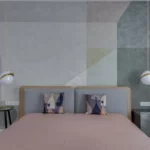Painting fence should be done at least once every two years to keep it in top condition. Over time, wood deteriorates and fades; whether you want to restore your fence or keep it looking new, a fresh coat of paint will preserve it from the elements and keep it looking great.
Various methods of painting fence
How to use a brush to paint a fence
Begin by doing a paint test on a scrap piece of wood. To confirm that the color is correct and that the paint adheres properly, paint or stain a small part of your fence.
You can begin painting fence along the top of the first fence panel, working vertically until it is completely coated in paint or stain. We suggest you read the Exterior painting Melbourne page for more details.
How to use a roller to paint a fence
Shake the can of stain or paint thoroughly after cleaning and preparing the area.
In a paint tray, add the paint or stain.
Using your largest roller, dip it about 12 inches into the paint/stain and begin to cover the fence. If you’re applying a stain, follow the grain of the wood.
Switch to a paintbrush once the fence’s flat parts have been painted.
You’ll then use your smaller roll to cut into the fence’s tight portions and borders.
It is best to wait for the first coat to dry before proceeding with the second.
Spray gun for painting
Getting the right tools and getting into the right posture is essential before you can begin spraying your fence. While spraying your fence, keep a 6-8 inch space between the nozzle of your spray gun and the fence.
Next, adjust the spray pattern on your nozzle. Set to spray vertically for rails or horizontal painting. Use an up-and-down motion with the spray gun to apply paint to fence panels. We suggest you read the Interior painting Melbourne page for more details.
Take your time and make sure you have all the complex cutwork and edges covered.
You must immediately apply the second coat after the first one has dried.
Advantages and Disadvantages of painting fence
Advantage: Customizability
Although the natural beauty of wood is appealing, not everyone prefers it. If you want to add some color to your yard, this is very important to keep in mind. Only black and brown are the only options when it comes to wood’s color palette. The versatility of paint is considered a benefit of painting fences. In contrast to wood, you can easily remove the paint and try a different one if you don’t like the color.
Disadvantage: Uneven Surfaces
The fact that paint tends to peel off over time is one of its drawbacks. Natural wood, when properly cared for, does not flake or chip like paint. When paint peels, it leaves a tangled mess of cracked pigment and primer behind. Because it requires less upkeep over time, all-natural styled wood is an excellent option for folks who dislike the concept of having to undertake regular maintenance.
Advantage: Longevity of the Fence
While skipping the priming and painting fence stages could save you time, it leaves your fence vulnerable to dangers that it could have avoided. Your fence can be protected from the weather with the use of primers, paint, and stain.
Disadvantage: Health and Environmental Risks
All-natural-looking fencing is a terrific option for individuals who want a more eco-friendly look. For one thing, it’s all-natural, which means that it doesn’t include any toxic or harmful chemicals like painted fences can have. We suggest you read the Commercial painting Melbourne page for more details.
Ideas for painting a fence in a nice way

Flowers and a monarch butterfly

Full garden painted fence

Under the sea fence
For a free consultation, finding out our prices, how long it will take to finish your project and any other inquiries, contact us at 0401345435. We are obligated to answer your questions and provide all the information you need for your projects.





